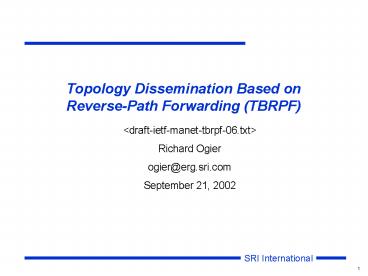Topology Dissemination Based on Reverse-Path Forwarding (TBRPF) - PowerPoint PPT Presentation
Title:
Topology Dissemination Based on Reverse-Path Forwarding (TBRPF)
Description:
In addition, grants a royalty-free license for non-commercial (research) use of ... HELLOs contain only neighbor RIDs (like OSPF) ... – PowerPoint PPT presentation
Number of Views:124
Avg rating:3.0/5.0
Title: Topology Dissemination Based on Reverse-Path Forwarding (TBRPF)
1
Topology Dissemination Based on Reverse-Path
Forwarding (TBRPF)
- ltdraft-ietf-manet-tbrpf-06.txtgt
- Richard Ogier
- ogier_at_erg.sri.com
- September 21, 2002
2
Major Changes for Version 06
- Section describing operation of TBRPF routing has
been rewritten to improve readability. - HELLO messages have been modified to include
relay priority. - New configurable parameter IMPLICIT_DELETION
indicates whether link deletions are implied by
link additions in topology updates. - Name has been changed by replacing Broadcast
with Dissemination. Acronym is still TBRPF. - New IPR statement gives away all rights to all
portions of TBRPF included in a jointly developed
protocol (posted on the IETF page of IPR
notices).
3
Improved Description of TBRPF Routing
- Organized with a separate subsection for each
procedure (e.g., Processing Topology Updates). - Pseudocode format changed Each procedure or
algorithm is described using numbered steps in
English, with less math notation. - Clarified that TBRPF computes the equivalent of
multipoint relays (MPRs). - MPRs are used for topology dissemination and
flooding of multiple interface and network prefix
information. - Nodes select themselves as MPRs with respect to a
subset of neighbors (in OLSR, an MPR is selected
by neighbors of the MPR). - Neighbors in the reportable node set RN are
equivalent to the MPR selectors of OLSR. - This equivalence makes it possible to merge TBRPF
with OLSR. For example, MPRs can be selected as
in OLSR while topology discovery is done as in
TBRPF.
4
Relay Priority
- Each node advertises its relay priority in each
HELLO. - A node with higher relay priority is more likely
to - Include more neighbors in RN
- Report a larger part of its source tree
- Be selected as a next hop relay.
- A node with relay priority 0 is equivalent to a
non-relay node, which was already supported in
previous versions of the draft. - Relay priority is similar to OLSRs relay
willingness (both teams independently decided to
add this feature).
5
Implicit Deletion Option
- If IMPLICIT_DELETION 1, then the addition of a
link (u,v) in a Topology Update implies the
deletion of any link (w,v) with the same head
node. (Valid if the node reports only links in
its source tree.) - Indicated by the implicit deletion bit in
Topology Updates. - If a node uses the option of reporting redundant
topology information (so that two links with the
same head node can be reported), then
IMPLICIT_DELETION must be 0, since in this case
link deletion cannot be implied by link addition.
6
New IPR statement for TBRPF
- Grants a royalty-free license to everyone for any
parts of TBRPF that either - become part of an IETF standard, or
- are included in a jointly developed protocol,
whether or not the protocol becomes a standard. - In addition, grants a royalty-free license for
non-commercial (research) use of TBRPF while it
is being evaluated by the IETF or is described in
an Experimental RFC. - No need to apply for a license automatic.
- Posted on the IETF page of IPR notices.
- May be modified based on feedback from the WG.
7
Implementation Status
- TBRPF has been implemented in Linux, ns-2, OPNET,
and Qualnet. - Has been tested in networks of PDAs using Cisco
and Lucent 802.11 cards. - Implementation is compliant with the latest
draft, but does not include optional features.
8
Rough plan for Experimental RFC
- Review packet format, and possibly make minor
changes to simplify it (e.g., exclude simple
mode and always use 8 bits for message type). - Current version supports only 255 neighbors (8
bits). Possibly include an option bit that
provides a 16-bit field for the number of
neighbors. - HELLOs contain only neighbor RIDs (like OSPF).
Possibly change this to neighbor interface IDs to
handle special situations that can occur in
wireless networks. - Possibly support multiple instances of TBRPF.
- Possibly support authentication, either using a
secret key and message digest as in OSPF, or
using the IP Authentication Header RFC 2402
proposed for IPSec. (This issue is common to all
MANET protocols.) - Additional details may be needed to completely
specify IPv6 operation. - Review draft for proper use of MUST, SHOULD, MAY,
etc. - Other recommended changes, including style
changes.































